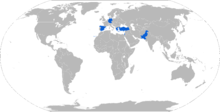DM2A4
| DM2A4 | |
|---|---|
 Map with DM2A4 operators in blue | |
| Type | Torpedo |
| Place of origin | Germany |
| Service history | |
| Used by | Germany, Israel, Pakistan, Spain, Turkey, |
| Production history | |
| Designer | Atlas Elektronik |
| Specifications | |
| Length | 6.6 m (22 ft) |
| Diameter | 533mm |
DM2A4 Seehecht (export designation "SeaHake mod 4" [1]) is the latest heavyweight torpedo developed by Atlas Elektronik for the German Navy, as a further update of DM2 (Deutsches Modell 2) torpedo which was released in 1976.
Description
Being the successor of the DM2A3, it features an advanced electrical propulsion system and a fiber optic cable for torpedo guidance and communication, which, in conjunction with advanced signals processing and mission logic, makes the torpedo largely countermeasure resistant.[2] The DM2A4/SeaHake mod 4 is the first torpedo ever to be guided by a fiber optic wire.[3] With a fully digital system architecture, increased range and speed and its new conformal array sonar with a very wide panoramic sensor angle as well as the additional wake-homing sensor, the DM2A4/SeaHake mod 4 provides greatly advanced performance over its predecessor. The homing head shell is a hydrodynamic optimised parabolic shape which aims to reduce torpedo self-noise and cavitation to an absolute minimum. The homing head's conformal transducer array permits detection angles of +/-100° in the horizontal and +/-24° in the vertical, therefore supporting larger acquisition angles in comparison to traditional flat arrays. The wide angle array is designed to reduce maneuvering when in search and reconnaissance stages, therefore also reducing self-noise and preserving battery power.
The weapon has a modular design that includes up to four silver zinc battery modules and is able to achieve a range of more than 50 km (27 nmi) and a speed exceeding 92.6 km/h (50 kn) powered by a high frequency permanent magnet motor, with a closed-loop cooling system independent from the environment. Exact performance data are classified.[4] The torpedo design template may also be used as the basis for ROV.[5] The weapon is armed with a 260 kg PBX, (RDX–aluminium) warhead (equivalent to 460 kg of TNT) with magnetic influence and contact fuzes.[5] The charge and fuse are insensitive and electromagnetic pulse safe.
The weapon has a length of 6.6 m when configured with 4 battery modules, and is respectively shorter when configured with either 3 or 2 battery modules depending upon the requirement of the operating unit. Diameter of the unit is 533 mm.
Service history
The torpedo is in service with the German Navy Type 212 submarines, has been delivered to the Pakistan Navy for service in the Agosta 90B submarines and has been selected by the Spanish Navy for its new S80A submarines.[6][7]
Operators
Current operators
See also
References
- ↑ DM2A4 Seehecht (SeaHake mod 4) p.4 German
- ↑ http://www.navweaps.com/Weapons/WTGER_PostWWII.htm DM2 A-4 Uses a fibre-optic-wire
- ↑ Todays Torpedoes [Archive] - SUBSIM Radio Room Forums
- ↑ GERMAN DM2A4 PROPULSION DECISION - Jane's Navy International
- 1 2 German Torpedoes Since World War II
- ↑ http://www.marine-portraits.de/deutsche-marine-bundesmarine/uboot-u-boot-submarine/klasse-212a/ 24 Torpedoes ATLAS DM2A4 per 212A
- ↑ http://dipbt.bundestag.de/dip21/btd/13/069/1306922.asc Anfrage Bündnis 90/Grüne betreff DM2A4, Beantwortung 04.02.1997
- ↑ Israel and Syria: The Military Balance and Prospects of War (Praeger Security International): Anthony H. Cordesman, Aram Nerguizian, Inout C. Popescu: 9780313355202: Amazon.co...